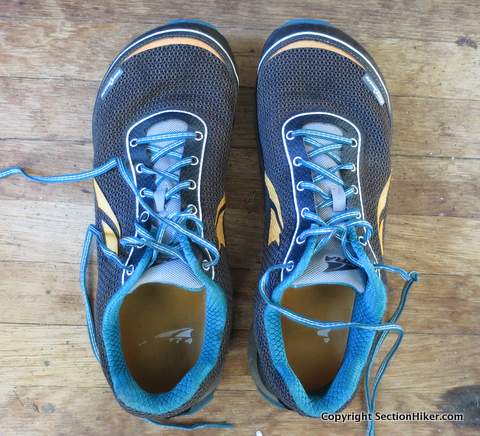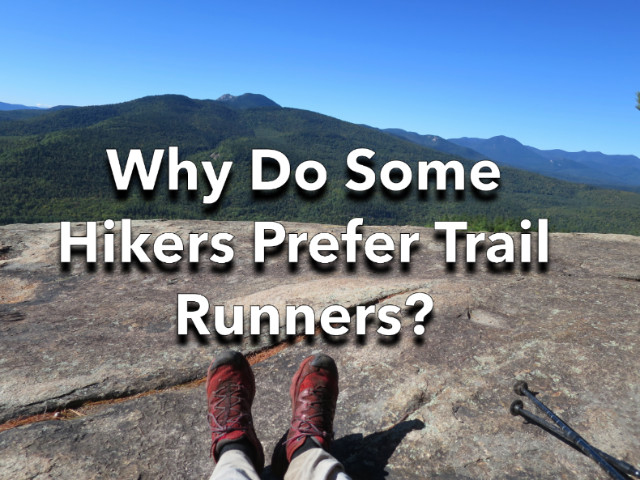
Many hikers and backpackers prefer wearing trail runners instead of hiking boots or mids. Trail runners are basically running shoes that are designed for running on trails and cross-country terrain with larger lugs for better traction on uneven terrain. But trail runners, hiking boots, and mids all have their pros and cons. You should wear the type of hiking boots or shoes that you feel comfortable wearing. We provide this information below if you’ve been considering a change but want information about why trail runners are preferred by some hikers.
Trail Runners for Hiking: Key Advantages
Hikers and backpackers like to wear trail runners because they:
- require little to no break-in time
- are cooler in hot weather
- cause fewer blisters
- have a larger toe box
- drain well when they get wet and dry faster than boots
- the softer soles that provide good traction for scrambling on rock
- they are lightweight
The devil is in the details, however, since switching to trail runners still requires knowing what to look for and trying lots of different trail runners on to see if they fit well and are designed to meet the conditions you need them to perform in. We provide a few hints below to get you started.
Little to No Break-in Time
Trail runners are lightweight running shoes with uppers that are soft and pliable out of the box. Many can be worn without little to no break-in time. That’s a different story with hiking boots or mids, especially leather hiking boots or mids, which can require as much as 50 miles of light hiking before they soften up.
That said, when trying a new pair of trail runners for the first time, it pays to be a little cautious. I usually tape my heels with Leukotape, which is a sticky blister prevention tape, when I try on a new make and model of trail runner that I’ve never used before. But when it comes to a replacement pair, I can usually put them on and go out for a hike without bothering to break them in.
Cooler in Hot Weather

Most trail runners have mesh uppers that are much cooler to wear in hot weather. In addition to better airflow, feet sweat a surprising amount, up to a 1/2 cup of water per day. That mesh allows the foot perspiration to evaporate, which has a cooling effect. While you can buy trail runners that have waterproof/breathable liners, most people don’t. That was one of the reasons trail runners first became so popular: because you could buy them without a waterproof/breathable liner, something that is nearly impossible with hiking boots or hiking mids.
Cause Fewer Blisters
Trail runners cause fewer blisters than heavier and thicker hiking boots and mids because they are softer and more pliable and because they keep your feet cooler. There’s an old saying when it comes to new hiking boots, that you need to “break your feet in” when you get a new pair of boots since they’re so overbuilt and have so little stretch in them. In other words, your feet need to adapt to the shoe, since the shoe isn’t going to adapt to your feet.
Trail runners, in contrast, adapt more easily to different foot shapes, both in the toes, under the tongue, and along the mid-foot. This causes less friction, which is what causes blisters because your foot is not fighting the shoe. Friction is also increased when you’re feet get hot and swell inside a hiking boot or shoe; but the mesh uppers in trail runners help keep your feet cooler so they swell less.
Larger Toe Box

Many trail runners, especially those from Altra Running, have a wider toe box than more traditional hiking boots or hiking shoes. This means your toes can spread out fully inside, which decreases the chance of blistering because they don’t rub together. Besides being a heck of a lot more comfortable, a wide toe box helps prevent or alleviate overuse injuries such as Morton’s Neuroma (toe nerve pain) which is experienced by about 1/3 of all hikers.
Drain and Dry Faster

Trail runners drain quickly when they get wet because the uppers are a porous mesh, as long as you get ones that don’t have a waterproof/breathable liner like Gore-tex. In contrast, if you’ve ever gotten hiking boots or hiking mids wet, you know that they can take several days to dry without an electronic boot dryer. This means you can walk through stream crossings with trail runners if you want, without carrying a second pair of stream crossing shoes, because your shoes will drain and dry so quickly. Furthermore, you’re less likely to get blisters if you get your trail runners wet because they are so soft and pliable and don’t cause extra friction.
Traction on Rock
If you do a lot of scrambling on rock, you’ll find that many trail runners have softer soles and lugs that provide better traction on rock, and even wet rock, than boots or mids with more rigid soles. La Sportiva, which also makes climbing shoes, probably has the trail runners with the stickiest soles, which make it easy to walk up surprisingly high-angle rock faces. Softer soles do wear down more quickly and of course, trail runners can’t be resoled, but then again there’s no thing as a free lunch.
Light Weight
Trail runners, for many of the aforementioned reasons, are also much lighter weight than hiking boots or hiking mids, which can put a little more spring in your step. The weight and energy saving adds up if you like to hike all day and can even result in an increase in the average number of miles you can hike in a day.

Trail Runners for Hikers: How to Choose
Hikers and backpackers are not trail runners and have slightly different requirements for traveling longer distances, a wider variety of terrain, and for a longer period of time. Here are some things that we encourage you to look for in trail runners for hiking.
Toe Protection
The amount of toe protection provided by trail runners varies widely. If you hike on rocky trails, you’re probably going to want a shoe that has a beefy toe kick up front and thick protective strips (usually TPU – thermoplastic polyurethane) running down the sides of the toe box. The frequent alternative is black or broken toenails. La Sportiva trail runners have the absolute best toe protection with thick rubber toe kicks and wrap-around toe box protection.
Rock Plate
A rock plate is a stiff piece of protective material inserted under the toe box or mid-foot to protect your foot from getting bruised by sharply pointed rocks or roots. Rock plates are common on trail runners designed for rugged trail running. Some trail runners, like the La Sportiva Jackal, even have full-length rock plates, to provide maximum protection for your entire foot.
Cushioning
Trail runners are available with different amounts of cushioning which reduces impacts on your feet, ankles, and knees. While a certain amount of cushioning is helpful, it can reduce the amount of proprioceptive trail feel that you get, which is useful for detecting uneven terrain, poor footing, or trip hazards. Trail runners with a moderate level of cushioning are the best for hiking and provide a good balance of protection and trail awareness.
Gaiter Trap
It’s important to wear gaiters with trail runners to prevent sticks, stones, and sand from getting into the back of your shoes. This is easiest to do if the shoes have a velcro tab in the back, often called a gaiter trap, like Altra’s trail runners. Otherwise, you’ll have to glue a piece of velcro behind the heel to hold a gaiter on. If that’s the case, carefully inspect the back of the heel to see if there’s a flat area to stick the velcro to, as this will help it stay on longer.
SectionHiker is reader-supported. We independently research, test, and rate the best products. We only make money if you purchase a product through our affiliate links. Help us continue to test and write unsponsored and independent gear reviews, beginner FAQs, and free hiking guides.

